
Skunks are infamous for their smelly spray, which they eject when threatened or frightened. First, they give a warning by hissing or stamping their feet, then raising their tail. If the warning is not heeded, the skunk can spray a foul-smelling yellow liquid a distance of 3 metres or more, from two anal glands. The appalling odour has been described as like a combination of rotten eggs, garlic and burnt rubber.
Most of the molecules responsible for the smell of the spray of the striped skunk (Mephitis mephitis) contain sulfur, as well as some quinolines (Figure 1). The thioacetates are less smelly than the thiols, but they slowly get hydrolysed by water, releasing the nauseating thiols. This explains why animals (such as domestic pets) that were sprayed by a skunk can suddenly start smelling ‘skunky’ again several days later, after getting wet. Some people recommend tomato juice to get rid of the smell if a person (or their pets) get sprayed. However, the best way is to oxidise the thiols to odourless sulfonic acids. This can be done with a mixture of hydrogen peroxide (as the oxidising agent) and baking soda (Figure 2).
Your organisation does not have access to this article.
Sign up today to give your students the edge they need to achieve their best grades with subject expertise
Subscribe




